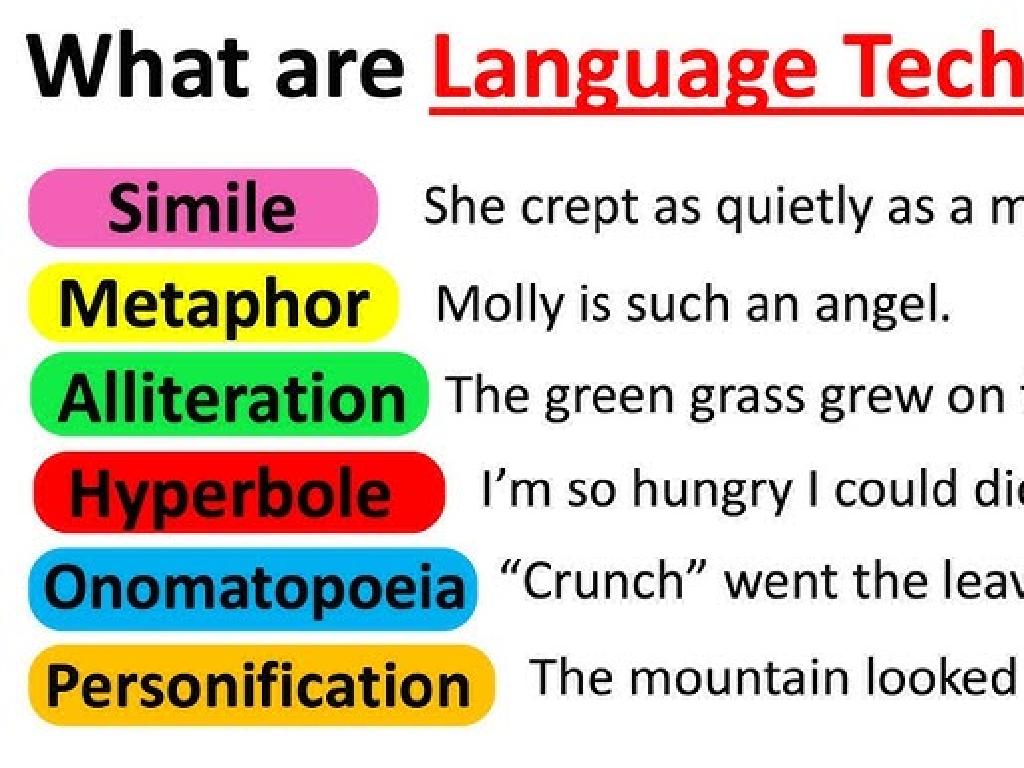Determine The Meaning Of Idioms From Context: Set 1
Subject: Language arts
Grade: Fifth grade
Topic: Idioms And Adages
Please LOG IN to download the presentation. Access is available to registered users only.
View More Content
Introduction to Idioms
– What are idioms?
– Phrases with a meaning different from the dictionary definitions of individual words.
– Purpose of using idioms
– To express ideas in a creative and vivid way.
– Examples of everyday idioms
– ‘Piece of cake’ means something very easy, ‘Break the ice’ means to start a conversation.
– Understanding idioms in context
– Use surrounding text to figure out what an idiom means.
|
This slide introduces students to the concept of idioms phrases that mean something different than the literal meanings of the words within them. Explain that idioms are used to make language more colorful and expressive. Provide examples of idioms that they might hear in everyday conversation, such as ‘piece of cake’ for something easy or ‘break the ice’ for starting a conversation. Emphasize the importance of context in understanding the meaning of idioms, as the literal meaning often doesn’t make sense. Encourage students to think of idioms they have heard and share them with the class.
Understanding Idioms
– Idioms: Not literal phrases
– Phrases where the whole meaning is different from the individual words, e.g., ‘It’s raining cats and dogs.’
– Idioms enhance expression
– They add color to our words and make our language more imaginative.
– Common in daily language
– We often use idioms without realizing it in conversations and writing.
– Reflect cultural nuances
– Idioms can give us insights into the values, beliefs, and history of a culture.
|
This slide introduces students to the concept of idioms, emphasizing that they cannot be understood by literal interpretation of the individual words. Instead, idioms convey a figurative meaning, which is often more expressive and creative. Highlight the prevalence of idioms in everyday communication and discuss how they enrich language. Explain that idioms also reflect cultural aspects and can vary from one region to another. Encourage students to think of idioms they have heard in their daily lives and consider the underlying meanings. Provide examples and ask students to guess the figurative meanings to make the lesson interactive.
Understanding Idioms: Set 1
– ‘Break the ice’ meaning
– To initiate conversation in a social event
– ‘Piece of cake’ explained
– Refers to a task that is very easy to complete
– ‘Spill the beans’ definition
– To disclose a secret unintentionally or prematurely
– Practice using idioms
|
This slide introduces students to the concept of idioms phrases that don’t mean exactly what the words say but have a different figurative meaning. ‘Break the ice’ is used when someone does something to create a more friendly and relaxed atmosphere. ‘Piece of cake’ is a phrase used when referring to a task that is very easy to accomplish. ‘Spill the beans’ is used when someone reveals a secret, often by accident. Encourage students to think of situations where these idioms could be used and to practice creating sentences with them. This will help them understand the idioms’ meanings and how they are used in everyday language.
Understanding Idioms in Context
– Context reveals idiom meanings
– Idioms are phrases with a meaning different from the words’ literal meaning.
– Read a story to find idioms
– As we read, look for phrases that don’t make sense literally.
– Discuss the meaning of each idiom
– We’ll talk about what each idiom suggests in the story’s setting.
– Apply idioms to our own experiences
– Think of times you’ve heard these idioms or could use them.
|
This slide introduces students to the concept of idioms phrases whose meanings cannot be understood from the individual words alone. By using context, students can infer the meaning of idioms within a narrative. Select a story that contains several idioms and guide the class through it, asking them to identify idiomatic expressions. After identifying the idioms, facilitate a discussion on their meanings within the context of the story. Encourage students to relate the idioms to their own experiences, which will help them remember and understand the idioms better. This activity will enhance their comprehension skills and their ability to interpret figurative language.
Practice with Idioms: Context Clues
– Fill in the blank with the right idiom
– Use context clues to figure out which idiom completes the sentence
– Match idioms to situations
– Think about what each idiom means and how it fits a specific scenario
– Create sentences with idioms
– Use your imagination to write a sentence that includes an idiom you’ve learned
|
This slide is designed to engage students in practical exercises that will help them understand idioms through context. Start by providing sentences with missing idioms and ask students to fill in the blanks using context clues. Then, present various situations and have students choose the most appropriate idiom for each one. Finally, encourage creativity by having students come up with their own sentences using idioms they’ve learned. This activity will reinforce their understanding of idioms and how they are used in everyday language. For the teacher: Prepare a list of idioms and their meanings for reference, and be ready to guide students through the exercises, offering examples and explanations as needed.
Class Activity: Idiom Charades
– Engage in Idiom Charades game
– Act out an idiom silently
– Use body language to convey the idiom’s meaning
– Classmates guess the idiom
– Observe and interpret the actions to guess
– Rotate turns among students
|
This activity is designed to help students learn idioms in a fun and interactive way. Each student will have a chance to express an idiom through charades, while the others guess. Before starting, explain what idioms are and give examples. Make sure to have a list of common idioms that fifth graders can understand. During the activity, encourage students to think creatively about how to act out their idiom. For the guessing students, prompt them to pay attention to context clues in the actions. Possible idioms for the activity: ‘Piece of cake’, ‘Break the ice’, ‘Let the cat out of the bag’, ‘Hit the nail on the head’. This will not only help with understanding idiomatic expressions but also with nonverbal communication skills.
Wrapping Up Idioms & Homework Task
– Review today’s idiom lessons
– Homework: Find an idiom
– Look in books or TV shows for a catchy phrase
– Write down the idiom’s meaning
– Use context clues to figure out what the idiom means
– Share your findings next class
|
As we conclude today’s lesson on idioms, remind students of the importance of context in understanding the meaning of idiomatic expressions. For homework, students are to find an idiom outside of class, in a book or a show, and decipher its meaning using context clues. Encourage them to think about how the idiom is used in the sentence to infer its meaning. In the next class, be prepared to facilitate a discussion where each student shares the idiom they found, its meaning, and how they determined it. This will help reinforce their learning and give them confidence in interpreting idioms. Provide examples of idioms and their meanings to guide them in their homework task.






